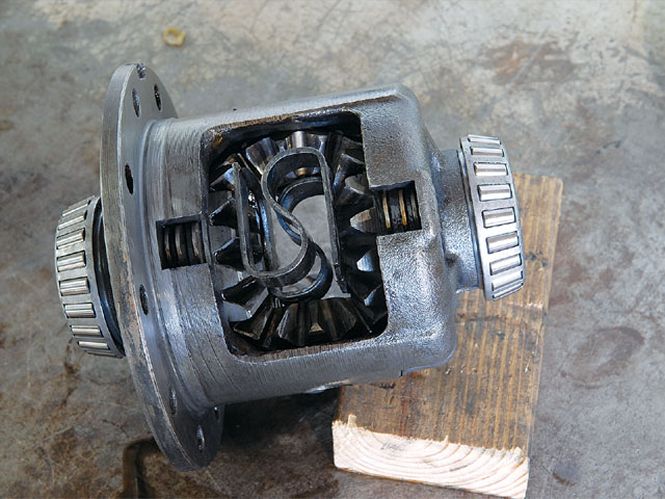This is the video which encouraged me to start this thread.
https://www.chassiss...St_p4VZ8ncHJvUg
In an attempt to get us talking about _something_ related to race cars, I’m going to attempt to start a differential conversation. We had a version of this conversation about a year ago a year when talking about Detroit lockers. If you have a question about those particular contraptions, I think the information there is reasonable and don’t want to spend a lot of time on a differential that few, if any of us, actually use. So this vid is an interesting analysis of a car with a spool, or locked, rear end. It’s not a differential as much as the lack thereof.
When simulating this car (He calls it a ‘musclecar’, so something like an Aussie V8 Supercar?). He finds the locked rear is superior to running several different types of limited slip differential (LSD). He finds it unusual that a locked rear is faster and seems a bit confused by it. To me, it’s not a terribly unusual finding, but I think just looking at the simulation gives us a very narrow view of the issue. So I thought we could kick around this situation a little and perhaps not want to shoot each other after the exchange.
How I see it:
- It’s a tin-top, so a relatively high C.G. which leads to a lot of lateral load transfer. It’s likely the inside rear has little load mid-corner, so it can’t apply a meaningful U/S moment.
- I suspect the initial suspension settings, if not the entire suspension design, is meant to counteract the effects of the spool. Just plopping in an LSD without changing other components likely produces excessive O/S.
- High power cars with little aero and low-ish lateral capacities are very dependent on powerdown performance to produce lap time. Speed traces are very ‘V’ shaped as opposed to more of a ‘U’ shape that you see with single-seaters. Corner minimum speeds and throttle initiation point are much less important than the point at which full throttle is reached. (I cannot stress this last sentence enough.)
- Cars with high C.G. heights often have unstable braking (large longitudinal load transfer). Spools produce braking and corner entry stability. It also eliminates single-wheel locking.
- A ‘Sim’ driver has perfect throttle control. One big issue with a spool is it produces an unstable understeer condition. This may sound unusual, but it’s not. I define stability as the car acting in the manner which the driver expects. If the car is stable at the limit, then its balance is consistent, but the controls just become less and less effective. For instance, a car might have limit oversteer, but if that O/S is progressive w.r.t. the driver’s inputs, then it’s not always a bad thing, because it’s predictable. A small amount of throttle produces a little O/S & a large amount of throttle produces a lot of O/S. Balance, whether understeer or oversteer, is not a surrogate for stability. That’s a separate trait.
- In this scenario, as small amounts of throttle, the car will have significant U/S, but, at the moment the inside rear tire would begin to spin, both rear tires spin and subsequently dump a massive percentage of their lateral capacity producing a large understeer to oversteer shift. Push, push push, going to throttle……Snap loose! This will be a difficult car to drive, particularly at a 90-95% pace.
- The unloading of the inside rear which allows a type of differential-like sliding will be a function of the suspension geometry and chassis tuning, but also of the lateral load transfer at any given moment. Banked, flat & off-camber turns will all have a different balance, as will any corner with meaningfully different tarmac or grip level.
- The above condition is particularly influenced by the rain. Expect to drive the thing tail-out in the wet, because it’s not going to turn on its own. There’s not enough lateral load transfer to lighten the inside rear.
- This is a good example of why the best Sims include a driver in the loop. The spool may be faster in theory, but it remains to be seen as to the actual drivability. Every driver I’ve worked with hates the push-to-snap loose condition. Because of this, they stay on the U/S side of the curve and rarely optimize the potential powerdown advantage. The (time) penalty for overstepping the grip level is too high.
- The idea that a spool can be fast reinforces Fatty’s Theorem of Race Car Handling: Starting from a nominally ‘balanced’ racecar, a 10% increase in U/S will slow the driver 1% while a 1% increase in O/S will slow the driver 10%. It’s much, much better in terms of performance to have a car with U/S rather than O/S. The O/S car might have a slight advantage in a qualifying situation where tires are new and the driver only has to produce a single lap, but over the course of a stint or race, it’s not a comparison. The U/S car will nearly always be the best option.
OK, many of us have some free time. Shall we?









-273-cropped2.jpg)









